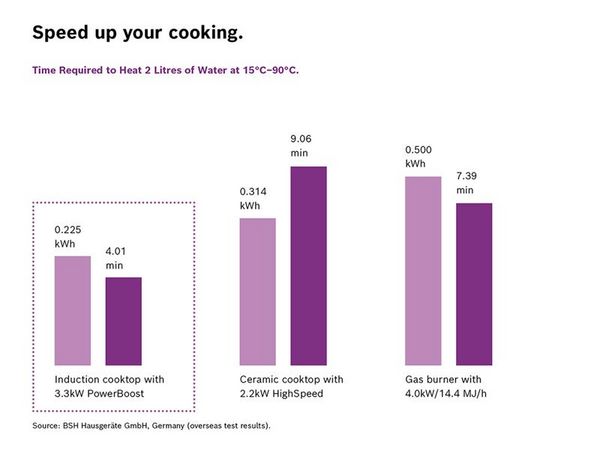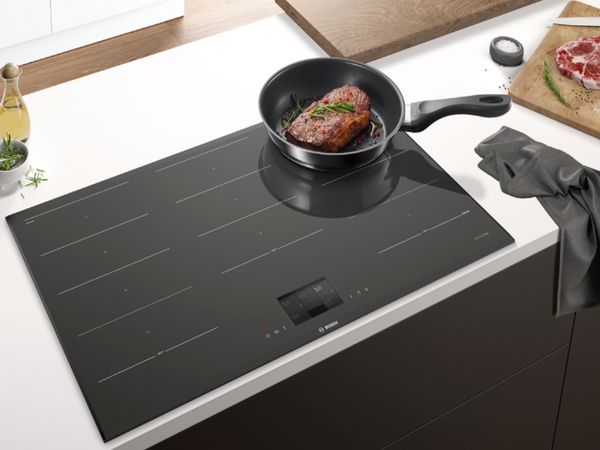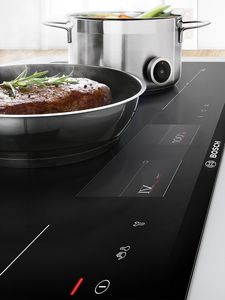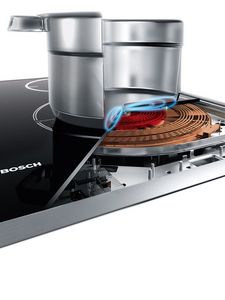Looking for the right cooktop? This guide explores the key differences between gas, induction, and ceramic options to help you choose the best fit for your kitchen. Whether you prioritise quick heating, energy savings, or easy installation, understanding how each type works will help you make a confident and informed decision.
So what’s the difference between Induction, Ceramic and Gas Cooking?
Induction cooktops only generate heat where it is needed – directly on the base of the pan. This improves energy efficiency, safety and allows for faster cooking. Ceramic cooktops on the other hand heat the glass on the cooktop, which then warms the base of the pan. Gas cooktops burn natural gas, creating heat around the base of the pan.Different cooktop technologies provide different benefits, from efficiency and speed, to flexibility and ease of installation.
Cooktop Features Overview

|

|

|
|
| Induction | Ceramic | Gas | |
| Quick to heat up | Fast | Moderate | Moderate |
| Easy to clean | ✔ | ✔ | X |
| Energy efficiency | High | Moderate | Moderate |
| Flexibility of cooking zones | Most flexible | Flexible | Least flexible |
| Direct heat transfer | ✔ | X | X |
| Quick heat response | ✔ | X | ✔ |
| Safety responsiveness | ✔ | X | X |
| Temperature controlled cooking , eg, via Perfect Fry / Perfect Fry Plus sensor* | Possible | Not possible | Possible |
| Cookware type | Induction compatible | Any | Any |
* Feature available on selected models.

Which cooktop is best for speed and control?
Induction cooktops offer the fastest and most precise cooking experience. Thanks to direct energy transfer to the cookware, they can bring 2 litres of water to a boil in nearly half the time of conventional cooktops.
And when you turn off the heat, the cooking stops almost instantly, similar to a gas cooktop - giving you greater control over every dish.

How easy is it to clean?
Induction cooktops are the easiest to clean. Because the glass surface only heats where it touches the pan, spills are less likely to burn on, making quick wipe-downs simple.
Ceramic cooktops have a similar smooth surface, but since the entire zone gets hot, food can burn onto the glass more easily, requiring a bit more effort to clean.
Gas cooktops are the most complex to maintain, with multiple parts, grates, and crevices where grease and crumbs can build up.
Gas is normally the most straightforward to connect, provided you already have a gas connection. Some induction and ceramic cooktops can need a lot of power to be able to run at their best, however Bosch also offers some induction cooktops that have comparatively low energy requirements, giving users the benefits of induction cooking, without the need for higher power loads.
Bosch Ceramic and Induction cooktops have various built in safety features depending on the model; such as a child lock, wipe protection, automatic safety switch off, and residual heat indicators. Additionally, induction cooktops know when cookware is on the cooktop, meaning they won’t heat if nothing is there to heat. Gas cooktops without electronics don’t have any of these safety benefits.
Induction and ceramic cooktops run on electricity, which means they can be more easily powered by renewable energy sources such as solar. This makes them a more sustainable choice for eco-conscious households.
However, your ability to run a cooktop entirely on solar power depends on the size and output of your renewable energy system. Most Australian homes use a 5kW inverter, which would be sufficient to power models like the Bosch Series 4 Induction Cooktops (with a total connected load of 4.6kW).
Higher-powered Bosch induction cooktops may exceed this limit, meaning they may not be fully powered by solar alone. For grid-connected homes, this isn’t a concern – any additional energy required will automatically be drawn from the electricity grid.
Gas and ceramic cooktops work with any cookware. However, because of the unique way induction cooktops heat, they require cookware with ferrous metal in it (such as iron or steel). Look for the words with induction sign on cookware if in doubt.
Tip: Checking if the base of a pot or pan is magnetic (i.e. if a magnet sticks to the base) is an easy way to see if it's induction compatible. Keep in mind, though, that the level of compatibility can vary depending on the material.
Induction cooktops have some of the best innovations to help make cooking easier. Sensors such as the PerfectFry and PerfectFry Plus sensor monitor temperature levels so you can cook more consistently and with better accuracy. We’ve also developed 2-in-1 induction cooktops with integrated ventilation. This appliance combines the latest technologies of our induction cooktops and rangehoods in a single appliance, ideal for kitchen islands.
So, what’s the verdict?
Bosch Gas cooktops are easy to install if you already have a gas cooktop. Ceramic cooktops are a cost-effective option to upgrade out of gas cooktops, however they lack the safety benefits, ease of cleaning and additional functionality of Induction. Bosch Induction cooktops are clear winners for speed of cooking, additional functionality, safety and energy-efficiency.












